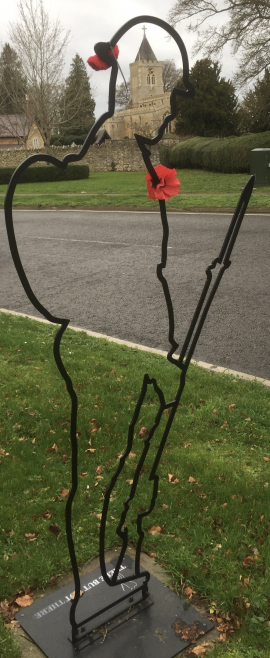There But Not There

On Monday 11th November 1918 at 11am, World War 1 came to an end. In just over 4 years over 9 million troops had died.
As part of the commemorations of the centenary of the end of WW1 the “There But Not There” silhouettes have been produced in the hope that villages and towns erect one as a tribute and as an act of remembrance to those who never came home. Turvey Parish Council purchased two such silhouettes, one near the zebra crossing and the other at Station End. Funds raised from their sale go to six charities: The Royal Foundation, Walking with the Wounded, Combat Stress, Commonwealth War Graves Foundation, Help for Heroes and Project Equinox.
Background to the End of World War 1
1918 was quite different from the war’s middle years; a static front line with the occasional advance measured in a few miles or yards. Technology had given armies more mobility with such innovations as tanks, which led to the development of better and more fluid infantry tactics. American troops began to arrive in western Europe in larger numbers too and, in one last push before the Americans were properly established as a fighting force, the Germans decided to make a final attempt to advance toward Paris in March, on a 55-mile front with 40 divisions. This came to a halt however after heavy German losses and with it the tide had turned with Germany in full retreat from June onwards.
Germany was suffering on the frontline and also at home as the Allied Naval blockades had prevented a lot of food reaching the country and consequently the army. There was civil unrest in Germany with communist revolutionaries putting pressure on the Kaiser. All of Germany’s overseas colonies had been overwhelmed by Allied nations such as Japan and China in the Far East and by British Commonwealth troops in Africa.
During October, Germany’s ally Turkey had signed an Armistice as British and Arab forces had crushed their army in the Middle East. Their other ally Austria-Hungary had also been defeated by Italian and allied forces on the Italian front.
Peace Talks
All of these factors contributed to the arrival of a delegation of German politicians driving up almost out of the blue to French lines on 7th November with a view to making peace. They were taken to meet Marshall Foch, supreme commander of Allied forces on the western front, at Compiegne north of Paris and eventually signed an Armistice on 11th November at 5am. It stated that hostilities would cease at 11am, which was hopefully enough time for the message to reach every man on the front line on both sides.
After 11th November 1918 the Allied armies occupied Germany and restored order. At the same time, they moved eastwards, as the aftermath of the Russian Revolution sought to spread communism westwards into the Baltic states and countries like Ukraine. To clarify, this was 1918 not 2018.
General Pershing, commander of the US Army on the Western Front was all for taking the battle into Germany so that the German people would see what the real cost of war was. He said that if we don’t take the war to them, they will never believe they have been beaten and we will have to do all this all over again…
Unless you learn from history you are condemned to repeat it





No Comments
Add a comment about this page